A Tour of the Cyranose® 320
by: Steve Hobbs
Technological advances over the past several years are prompting a revolution in analytical chemistry. This revolution has been happening on two fronts simultaneously. First analytical instruments are changing from large, bulky laboratory devices to miniature, low power and portable devices. This transformation in analytical chemistry is physically obvious and is well underway. The second revolution is also enabled by advances in technology but is more subtle. This revolution can be described as a change from a complex information science to a decision-making science. As shown in Figure 1 the conventional analytical process may involve several time and labor-intensive steps including methods development, sampling, transportation of the sample to the lab, sample preparation, separation, data workup, interpretation of results, transportation of the decision back to the sampling site, reading and acting on the decision. In the conventional process complex samples have to be separated into their individual chemical components before a decision can be made. New technologies and automation are making this long process unnecessary for many analytical applications.

The simplified decision-making process can be implemented with a class of instruments known as electronic noses. These devices are called electronic noses because they mimic the human olfactory process. Noses contain a number of individual chemical sensors. Each sensor has a nonspecific response to a vapor mixture being examined. In other words, each sensor responds to every analyte mixture but to varying degrees. An example of the response of an electronic nose is shown in Figure 2 in which good packaging material is distinguished from packaging material that has an odor. The electronic nose has 32 sensors, each of which respond to the good and bad packaging. Individual sensors cannot reliably distinguish between the two materials. However, as a group the sensors form a pattern or "smellprint" that can be used to distinguish the two materials. Note that unlike traditional analytical techniques, there is no need to separate the packaging vapor into their individual components.

The Cyranose® 320 shown in Figure 3 is an electronic nose that made its debut at Pittcon 2000. The device can be trained to distinguish complex vapor mixtures as easily as simple vapors. It is designed to follow the simple process of training, sampling and reporting so that decisions can be made immediately without ever leaving the sample site. The user trains the Cyranose® 320 by exposing the sensor to each type of sample that will be encountered during testing. Careful selection of the types of samples must be made so that the full range of conditions is covered. After one training session the device can be used repeatedly without retraining. The sampling step involves placing the tip of the Cyranose® 320 near the sample and simply pressing run. The air reference, vapor sampling, sensor measurements and data processing are all handled automatically and take roughly one minute to complete. The unit then reports which type of sample in the training set is most closely like the present sample. The unit then automatically purges itself for a user-defined amount of time, typically a couple of minutes and the polymer composite sensors return to their original resistances.
The Cyranose® 320 differs from previous electronic noses in a number of ways. The primary difference is that it is based upon a new sensor technology called polymer composite sensors that has been licensed from the California Institute of Technology. The Cyranose® 320 contains an array of 32 sensors, each of which consists of a pair of electrical contacts that are bridged by a composite film (Figure 4.) Typically the film for each sensor is made of a composite of a nonconducting polymer and conductive carbon black particles. When the film absorbs vapor analytes and swells, the conductive pathways in the film are broken and the resistance of the composite film changes. The change in resistance between the electrical contacts is used as the output of the sensor. Since each sensor in the array contains a unique polymer, there will be a reproducible combination of resistances or "smellprint" for each vapor mixture. Polymers with a range of properties were chosen so that the sensor array could be used to distinguish many different types of vapors.

For all electronic noses the "smellprint" is used to distinguish the vapor through the use of training and prediction algorithums such as multivariate analysis. The Cyranose® 320 has advanced multivariate techniques. The unit uses principal component analysis (PCA) for detection of outliers and data reduction along with three supervised algorithms for model building and predictions. The three supervised algorithms are K-nearest neighbor (KNN), K-means and Canonical Discriminant Analysis (CDA).
Electronic noses using polymer composite sensors are found in a broad range of applications. Application areas include quality control, process measurement, hazardous materials identification, leak detection, bacterial identification and aroma identification. Arranged by industry the application areas include defense and homeland security, food and beverage, packaging, petrochemical, industrial chemicals and hygiene products.
One example of an application of the polymer composite technology is the distinction of essential oils. As shown in Figure 5 samples of peppermint, lemon oil, two spearmint oils, bitter almond and sweet orange were separated using PCA.

The polymer composite sensor technology in the Cyranose® 320 offers a number of attractive features that complement complex analytical methods such as gas chromatography. The device is a handheld portable that is simple to use and economical. It provides a response rapid enough to be used on site. Numerous types of vapor molecules can be discriminated since the 32 polymers in the Cyranose® 320 have a range of vapor solvation properties. These features allow the Cyranose® 320 to find a number of uses.



